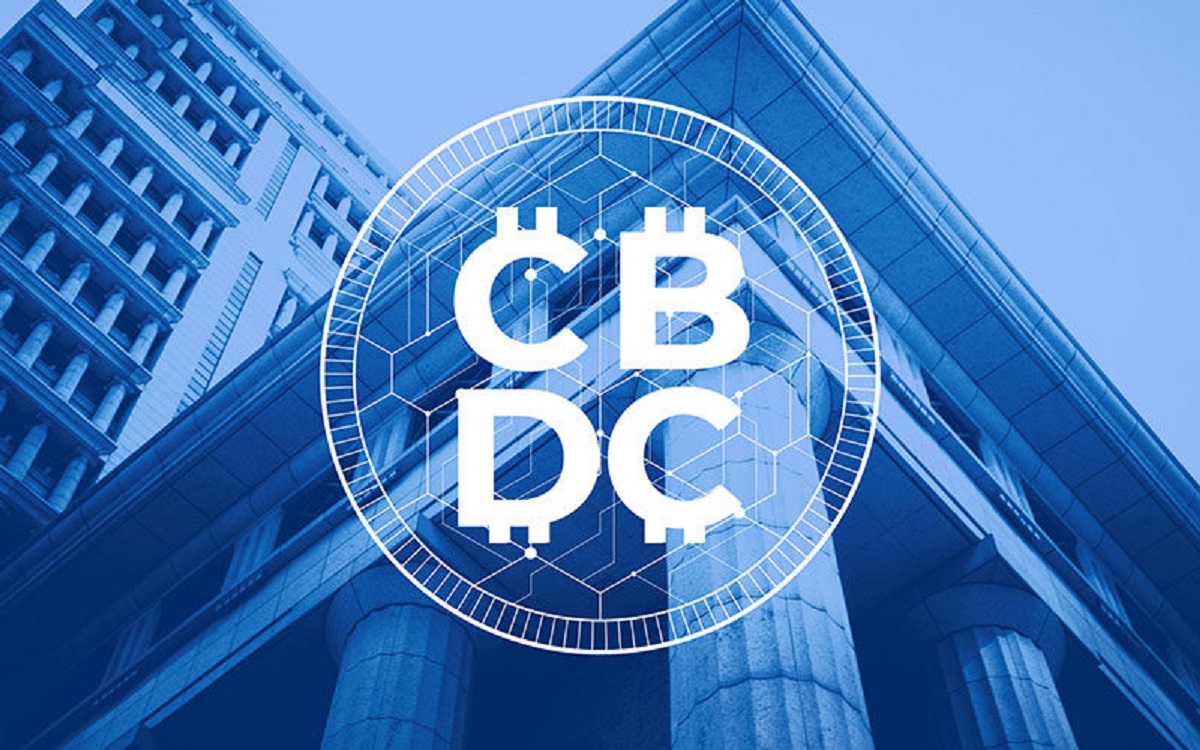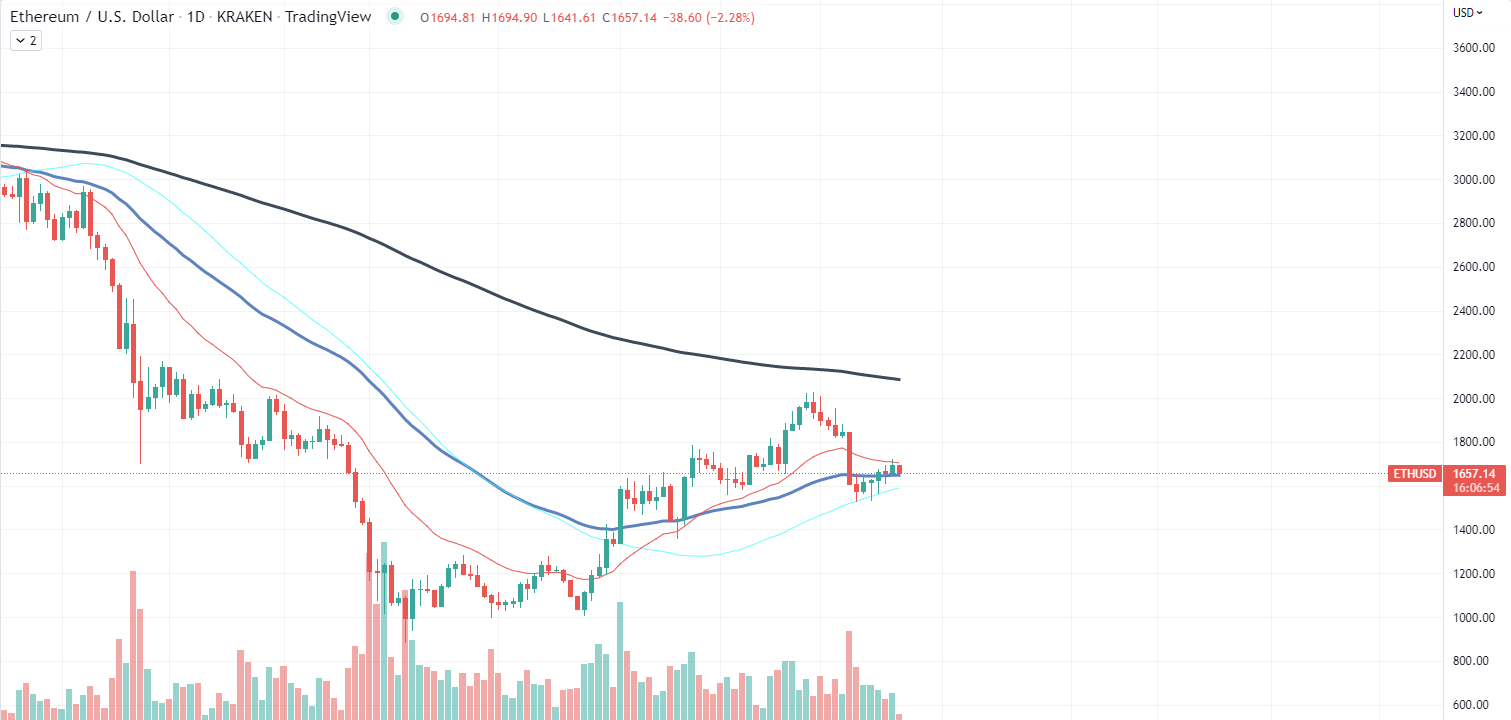Introduction
Welcome to the world of Central Bank Digital Currencies, or CBDCs. As the global financial landscape continues to evolve, central banks are exploring the potential of issuing their own digital currencies. CBDCs have gained increasing attention and are poised to revolutionize the way we transact, store value, and interact with money.
A CBDC is a digital representation of a country’s fiat currency, issued and regulated by the central bank. Unlike traditional physical cash or digital payment systems provided by commercial banks, CBDCs would be directly regulated by the central authority. This new form of money aims to combine the convenience and efficiency of digital transactions with the stability and security of centralized control.
The concept of CBDCs brings forth a range of potential benefits. First and foremost, CBDCs have the potential to increase financial inclusion, enabling those without access to traditional banking systems to participate in the digital economy. Additionally, CBDCs could enhance the efficiency of cross-border transactions, reduce costs, and provide increased transparency in the financial system.
However, the implementation of CBDCs also comes with a set of challenges. Central banks need to address concerns around privacy, cybersecurity, and the potential impact on financial stability. Furthermore, the adoption of CBDCs requires collaboration and cooperation between governments, regulators, and the private sector.
One of the key technologies being explored for the implementation of CBDCs is blockchain. Blockchain, originally developed as the underlying technology for cryptocurrencies like Bitcoin, offers a decentralized and secure framework for recording transactions. The use of blockchain in CBDCs has the potential to enhance transparency, immutability, and efficiency in financial transactions.
In this article, we will delve into the different types of blockchains and their suitability for CBDC implementation. We will explore public blockchains, private blockchains, permissioned blockchains, and hybrid blockchains, and discuss how they can be utilized to build and operate CBDC systems. Additionally, we will analyze the factors that central banks need to consider when choosing the right blockchain platform for their CBDCs.
Join us as we navigate the intricate world of CBDCs and explore the exciting potential that blockchain technology holds in revolutionizing the future of money.
What is a CBDC?
A Central Bank Digital Currency (CBDC) is a digital form of a country’s fiat currency that is issued, regulated, and controlled by the central bank. Unlike traditional currencies that exist as physical cash or digital currencies issued by commercial banks, CBDCs are directly backed by the central authority and represent a digital representation of the national currency.
CBDCs are designed to combine the benefits of digital transactions with the stability and security provided by centralized control. They aim to enable faster, more efficient, and secure transactions while maintaining the trust and stability associated with a national currency.
One of the defining features of CBDCs is that they are issued and regulated by the central bank. This means that the central bank would have full control over the supply, distribution, and management of the digital currency. CBDCs can be created using various technological frameworks, with blockchain being a key technology under consideration.
CBDCs have the potential to bring about a range of benefits. First and foremost, they have the potential to increase financial inclusion by providing a digital payment system accessible to all individuals, even those who do not have access to traditional banking systems. This can help bridge the gap between the banked and unbanked populations, promoting greater economic participation and opportunity.
Additionally, CBDCs can enhance efficiency in cross-border transactions by reducing complexities and costs associated with traditional remittance systems. The use of digital currencies can enable near-instantaneous settlement, reducing the time and fees typically associated with cross-border transfers.
Another potential benefit of CBDCs is increased transparency. With CBDCs recorded on a blockchain or similar distributed ledger, transactions can be easily audited and monitored, reducing the potential for illicit activities such as money laundering and fraud.
Despite the potential benefits, the implementation of CBDCs also poses challenges. Central banks need to carefully consider factors such as privacy, cybersecurity, scalability, and the potential impact on financial stability. These challenges require thorough research, rigorous testing, and careful design to ensure the successful implementation and adoption of CBDCs.
In the next section, we will explore the various benefits and challenges associated with CBDCs in more detail, delving into the transformative potential of these digital currencies.
Benefits of CBDCs
Central Bank Digital Currencies (CBDCs) offer a range of potential benefits that could reshape the financial landscape. These benefits include increased financial inclusion, enhanced efficiency in transactions, and improved transparency in the financial system.
One of the primary advantages of CBDCs is their potential to increase financial inclusion. By providing a digital payment system that is accessible to all individuals, regardless of their access to traditional banking services, CBDCs can help bridge the gap between the banked and unbanked populations. This can empower individuals in underserved areas, enabling them to participate fully in the digital economy and have access to basic financial services.
Furthermore, CBDCs can significantly enhance the efficiency of transactions. Compared to traditional payment systems that require intermediaries and can take days for settlement, CBDCs can enable near-instantaneous transactions. This can provide a seamless and convenient experience for individuals and businesses, reducing the time, cost, and complexity associated with traditional payment methods.
In the realm of cross-border transactions, CBDCs have the potential to revolutionize the process. Currently, cross-border transactions often involve multiple intermediaries, currency conversions, and lengthy settlement times. CBDCs can streamline this process by eliminating intermediaries, reducing fees, and enabling faster settlement. This can result in quicker and more cost-effective cross-border transactions, benefiting individuals and businesses alike.
Another advantage of CBDCs is the potential for increased transparency in the financial system. By leveraging technologies like blockchain, CBDC transactions can be recorded in a decentralized and immutable manner. This transparent record-keeping offers enhanced traceability and auditability, reducing the potential for fraudulent activities and improving regulatory oversight.
Additionally, CBDCs can contribute to greater financial stability. As CBDCs would be regulated and controlled by the central bank, they can provide a stable form of digital currency that is less susceptible to economic fluctuations. This stability can bolster trust and confidence in the financial system, providing individuals and businesses with a more reliable medium of exchange and store of value.
Overall, CBDCs have the potential to transform the financial landscape by increasing financial inclusion, enhancing transaction efficiency, improving transparency, and promoting stability in the financial system. However, it is important to carefully consider and address the challenges and risks associated with the implementation of CBDCs to ensure their successful integration into the existing monetary ecosystem.
Challenges of CBDCs
While Central Bank Digital Currencies (CBDCs) offer numerous potential benefits, their implementation also poses several challenges that need to be carefully addressed. These challenges include privacy concerns, cybersecurity risks, adoption barriers, and the potential impact on monetary policy.
One of the key challenges of CBDCs is ensuring privacy in digital transactions. As CBDCs are digital currencies directly regulated by the central bank, there is a need to strike a balance between preserving privacy and preventing illicit activities. The design of CBDCs needs to address concerns related to data protection, identity theft, and unauthorized access to personal information.
Cybersecurity is another significant challenge in the implementation of CBDCs. Digital currencies, by their nature, are vulnerable to cyberattacks and hacking attempts. The central banks responsible for issuing CBDCs need to implement robust security measures to protect against cyber threats and safeguard the integrity of the digital currency system.
Moreover, the adoption of CBDCs may face barriers. People who are accustomed to traditional payment systems may be hesitant to embrace digital currencies due to concerns about usability and reliability. Creating user-friendly interfaces, ensuring compatibility with existing financial infrastructures, and educating the public about the benefits of CBDCs can help address these adoption barriers.
Another challenge is the potential impact on monetary policy. CBDCs could change the dynamics of monetary policy as the central bank gains direct control and real-time visibility over all transactions. This requires careful consideration and potential adjustments to existing monetary policy frameworks to align with the unique characteristics of CBDCs.
Additionally, interoperability between different CBDC systems and traditional payment infrastructures is a challenge that needs to be addressed. Ensuring seamless integration and interoperability can enhance the usability and acceptance of CBDCs, enabling smooth transactions between different digital payment platforms.
Furthermore, the scalability of CBDCs is a significant challenge. The digital infrastructure supporting CBDCs must be capable of handling high transaction volumes and ensuring fast processing times. Scalability solutions need to be implemented to ensure that CBDCs can handle the increasing demand as adoption grows.
Addressing these challenges requires close collaboration between central banks, governments, regulators, and technology providers. Thorough research, extensive testing, and continuous evaluation are essential to identify and mitigate risks while leveraging the potential benefits of CBDCs.
By effectively addressing these challenges, CBDCs can evolve into a secure, efficient, and accessible digital payment system that benefits individuals, businesses, and the overall economy.
The Role of Blockchain in CBDCs
Blockchain technology plays a significant role in the development and implementation of Central Bank Digital Currencies (CBDCs). This decentralized and immutable ledger offers several key advantages that make it an attractive solution for CBDC systems.
One of the primary benefits of utilizing blockchain in CBDCs is enhanced transparency. Blockchain enables the recording of transactions in a decentralized manner, creating an immutable and transparent audit trail. This transparency can provide increased visibility into the flow of funds, allowing for better regulatory oversight and reducing the potential for illicit activities.
Additionally, blockchain technology offers improved security for CBDC transactions. The decentralized nature of blockchain ensures that no single entity can manipulate or control the transaction data, enhancing the resilience against hacking and fraud attempts. The use of cryptography in blockchain further enhances data security and protects the integrity of CBDC transactions.
Another advantage of blockchain is its potential for increased efficiency in CBDC systems. Blockchain can facilitate near-instantaneous settlement of transactions, eliminating the need for intermediaries and reducing the time, cost, and complexity typically associated with traditional payment systems. This can result in faster and more cost-effective digital transactions for individuals and businesses.
Moreover, blockchain technology can facilitate interoperability between different CBDC systems. By utilizing standardized protocols and smart contracts, CBDCs built on blockchain can seamlessly interact with each other, enabling cross-border transactions and promoting global financial integration.
Furthermore, the decentralized nature of blockchain can help reduce the risks associated with centralized control. By distributing transaction records across a network of nodes, blockchain provides a higher level of resilience against system failures and attacks. This decentralized architecture ensures that CBDC systems are less vulnerable to single points of failure, enhancing the overall stability and reliability of the digital currency ecosystem.
However, it is important to consider the trade-offs associated with blockchain technology. Blockchain can face challenges in terms of scalability, energy consumption, and governance. These aspects need to be carefully managed and optimized to ensure the successful implementation and operation of CBDC systems.
Overall, blockchain technology offers significant potential in revolutionizing CBDCs. Its transparent, secure, efficient, and decentralized properties make it a compelling option for central banks looking to digitize their national currencies. By leveraging the benefits of blockchain, CBDCs can transform the way financial transactions are conducted, enhancing trust, efficiency, and accessibility in the global economy.
Different Types of Blockchains
When it comes to implementing a blockchain-based system for Central Bank Digital Currencies (CBDCs), there are various types of blockchains to consider. Each type has its own characteristics, advantages, and use cases. Let’s explore the different types of blockchains: public blockchains, private blockchains, permissioned blockchains, and hybrid blockchains.
Public Blockchains: Public blockchains are open and decentralized networks accessible to anyone. These blockchains, such as Bitcoin and Ethereum, rely on a large number of nodes distributed worldwide to validate and record transactions. Public blockchains offer high levels of security and transparency but are less suitable for CBDCs due to concerns related to privacy, scalability, and regulatory compliance.
Private Blockchains: Private blockchains are restricted networks where only authorized entities can participate. These blockchains are typically used within organizations or consortia, enabling them to leverage the benefits of blockchain technology while maintaining control over the network. Private blockchains offer faster transaction processing, enhanced privacy, and greater scalability compared to public blockchains.
Permissioned Blockchains: Permissioned blockchains combine elements of both public and private blockchains. These blockchains limit participation to a predetermined set of approved entities, granting them permission to validate transactions and maintain the network. Permissioned blockchains provide a balance between decentralization and control, making them suitable for CBDCs, as they allow for regulatory compliance and offer privacy features while maintaining network security.
Hybrid Blockchains: Hybrid blockchains combine multiple aspects of different blockchain types. They can be a combination of public and private or permissioned blockchains, allowing for flexibility in terms of accessibility, security, privacy, and scalability. Hybrid blockchains can provide a customizable solution for CBDCs, enabling central banks to tailor the blockchain network based on their specific requirements and objectives.
Choosing the right type of blockchain for CBDCs involves considerations such as security, scalability, privacy, regulatory compliance, and the level of control desired by central banks. While public blockchains offer high security and transparency, they may pose challenges related to privacy and regulatory compliance. On the other hand, private and permissioned blockchains offer more control and privacy but sacrifice some aspects of decentralization.
It’s important for central banks to carefully evaluate their needs, requirements, and the trade-offs associated with each type of blockchain before making a decision. Collaboration and partnerships with technology providers and industry experts can help central banks navigate the complexities of blockchain technology and choose the most suitable blockchain type for their CBDC implementation.
In the next sections, we will explore how each type of blockchain can be utilized for CBDCs, highlighting their strengths and potential use cases.
Public Blockchains
Public blockchains are decentralized networks accessible to anyone and are maintained by a distributed network of nodes around the world. These blockchains, such as Bitcoin and Ethereum, operate on a consensus mechanism that enables trust and transparency without relying on a central authority. While public blockchains offer several advantages, they also present challenges when it comes to implementing Central Bank Digital Currencies (CBDCs).
Public blockchains provide a high level of security due to their decentralized nature. As transactions are validated by multiple nodes, the risk of fraud or manipulation is significantly reduced. The transparency of public blockchains ensures that all transactions are visible to anyone on the network, making it easy to trace funds and verify the integrity of the system.
However, privacy is a concern with public blockchains. Transactions on public blockchains are visible to all participants, which may not align with the privacy requirements of CBDCs. Privacy-enhancing technologies, such as zero-knowledge proofs, can be utilized to address this concern, but they may introduce additional complexities and trade-offs.
Another challenge of utilizing public blockchains for CBDCs is scalability. Public blockchains often face scalability limitations as the number of participants and transactions grows. The large number of users and the computational overhead required for consensus can lead to slower transaction processing times and higher fees. This scalability challenge needs to be addressed for CBDCs to handle the volume and speed required for everyday transactions.
Furthermore, public blockchains may present regulatory challenges. As they are open to anyone, they are not designed to adhere to certain regulations and compliance requirements that are crucial for a national currency. Central banks need to ensure that the characteristics of a public blockchain, such as pseudonymity and global accessibility, are compatible with the regulatory frameworks in place.
Despite these challenges, there are potential use cases for public blockchains in the realm of CBDCs. For example, public blockchains can be utilized for interbank settlements or cross-border transactions, where the transparency and security of the blockchain can help streamline processes and reduce friction. Additionally, public blockchains can foster innovation and ecosystem development through the creation of decentralized applications (DApps) and smart contracts.
In summary, while public blockchains offer security, transparency, and global accessibility, they may face challenges in terms of privacy, scalability, and regulatory compliance. Central banks considering the use of public blockchains for CBDCs need to carefully assess these challenges and evaluate the trade-offs before deciding on their implementation.
Private Blockchains
Private blockchains are restricted networks where only authorized entities can participate in validating transactions and maintaining the blockchain. These blockchains offer a higher degree of control and privacy compared to public blockchains, making them a viable option for Central Bank Digital Currencies (CBDCs) that require regulatory compliance and controlled access.
One of the primary advantages of private blockchains is enhanced transaction speed and scalability. Since private blockchains have a limited number of participants, they can achieve faster transaction processing compared to public blockchains. The reduced computational overhead and consensus requirements enable private blockchains to handle a higher volume of transactions, making them suitable for CBDCs that require fast and efficient payment systems.
Private blockchains also provide heightened privacy and confidentiality, as access to the blockchain network is restricted to authorized participants. This makes private blockchains more aligned with the privacy requirements of CBDCs, as sensitive transaction details can be kept confidential within the network. Additionally, private blockchains can implement permission levels to control access to data, ensuring that only authorized entities can view and participate in the network.
Moreover, private blockchains offer greater control and governance compared to public blockchains. Central banks can have direct oversight and enforce regulations within the CBDC system, ensuring compliance with monetary policies and regulatory frameworks. This level of control is essential for the stability and integrity of the national currency.
However, the use of private blockchains introduces certain trade-offs. They are more centralized compared to public blockchains, as they rely on a limited number of trusted entities to validate transactions. This centralized validation process may raise concerns about network resilience and the potential for collusion among participants. The need for trust among the participants also requires careful selection and vetting to ensure the security and integrity of the blockchain network.
Another consideration for private blockchains is the potential for interoperability with other blockchain networks or traditional financial systems. The compatibility and integration of private blockchains with existing payment infrastructures need to be carefully addressed to enable seamless transactions and cross-border interactions.
Private blockchains can be advantageous for CBDCs that prioritize controlled access, transaction speed, and privacy. They are suitable for use cases where a more centralized and regulated approach is necessary, such as interbank settlements, private sector collaborations, and government-related transactions.
In summary, private blockchains provide faster transaction processing, enhanced privacy, and greater control for CBDCs. While they bring certain trade-offs, such as centralization and potential interoperability challenges, the benefits of control, scalability, and privacy make private blockchains a compelling option for central banks exploring the implementation of CBDCs.
Permissioned Blockchains
Permissioned blockchains strike a balance between the openness of public blockchains and the control of private blockchains. In permissioned blockchains, access to the network is restricted to a pre-approved group of participants who are granted permission to validate transactions and maintain the blockchain. This type of blockchain offers several advantages that make it a suitable option for Central Bank Digital Currencies (CBDCs) that require regulatory compliance and specific access controls.
One of the primary benefits of permissioned blockchains is enhanced privacy and confidentiality. Unlike public blockchains where all transactions are visible to anyone, permissioned blockchains provide a higher degree of privacy. Access to the blockchain network is granted to authorized participants who can view and validate transactions, ensuring that sensitive transaction details remain confidential within the network.
Permissioned blockchains also offer improved scalability compared to public blockchains. Since the number of participants is limited and known, permissioned blockchains can handle a higher volume of transactions and achieve faster processing times. This scalability advantage ensures that CBDCs built on permissioned blockchains can handle the demands of a large-scale digital currency system.
Moreover, permissioned blockchains provide a higher degree of control and governance. Central banks can set the rules, define the consensus mechanisms, and enforce regulatory requirements within the network. This level of control is crucial for maintaining the stability, integrity, and compliance of a CBDC system.
Another significant advantage of permissioned blockchains is the potential for regulatory compliance. Since access to the blockchain network is restricted to authorized entities, permissioned blockchains can more easily align with existing regulations and compliance frameworks. This is particularly important for CBDCs, as central banks need to ensure that the implementation of digital currencies adheres to legal and regulatory requirements.
However, permissioned blockchains do come with certain considerations. While they provide a higher level of privacy compared to public blockchains, they may still require additional privacy-enhancing techniques to meet the specific requirements of CBDCs. This includes technologies like zero-knowledge proofs or confidential transactions that provide further privacy protections.
Furthermore, permissioned blockchains may face challenges in terms of interoperability with other blockchain networks or traditional financial systems. Interoperability solutions and standardization efforts are necessary to enable seamless transactions and connectivity between different permissioned blockchain implementations.
In summary, permissioned blockchains offer enhanced privacy, scalability, control, and regulatory compliance for CBDCs. The controlled access to the network ensures privacy and confidentiality, while the scalability and governance features make permissioned blockchains suitable for large-scale financial transactions. With careful design and appropriate privacy-enhancing technologies, permissioned blockchains can provide a robust and compliant infrastructure for the implementation of CBDCs.
Hybrid Blockchains
Hybrid blockchains combine elements of both public and private or permissioned blockchains, offering a flexible and customizable approach for Central Bank Digital Currencies (CBDCs). This type of blockchain leverages the strengths of different blockchain models to address specific needs and requirements, making it an attractive option for central banks exploring the implementation of CBDCs.
With hybrid blockchains, central banks have the flexibility to determine which parts of the CBDC system should be public and which should be private or permissioned. This allows for a more tailored approach that meets the specific objectives, regulatory requirements, and privacy considerations of the CBDC implementation.
For example, a CBDC system built on a hybrid blockchain might utilize a public blockchain for transparent transaction recording, enabling external visibility and auditability. At the same time, certain aspects of the system, such as transaction validation and access to sensitive data, can be restricted to authorized participants on a private or permissioned layer.
By leveraging a hybrid blockchain approach, CBDCs can benefit from the transparency and security provided by public blockchains while maintaining control, privacy, and compliance requirements through private or permissioned layers. This enables central banks to strike a balance between transparency and regulatory oversight without compromising on the privacy and confidentiality of sensitive transaction details.
Furthermore, hybrid blockchains can tackle scalability challenges that might arise with public blockchains. By separating transaction verification onto a permissioned layer, participants can achieve faster processing times and increased scalability, ensuring that the CBDC system can handle high transaction volumes efficiently.
In terms of interoperability, hybrid blockchains offer opportunities for seamless connectivity with other blockchain networks or traditional financial systems. The flexibility of hybrid blockchains allows for the development of standardized protocols and bridges that facilitate interaction between different blockchain ecosystems, promoting cross-chain interoperability and enabling interoperability with existing payment infrastructures.
However, implementing a hybrid blockchain requires careful design and consideration of various technical and governance aspects. Central banks need to determine the appropriate balance between public and private or permissioned layers, evaluate potential trade-offs, and establish the necessary protocols and standards for interoperability.
In summary, hybrid blockchains provide central banks with a customizable approach for CBDCs, allowing them to leverage the advantages of both public and private or permissioned blockchains. By tailoring the blockchain infrastructure to specific needs, central banks can achieve a balance between transparency, privacy, scalability, and regulatory compliance, offering an optimal solution for CBDC implementation.
How Different Blockchains Can be Used for CBDCs
Central Bank Digital Currencies (CBDCs) can leverage different types of blockchains to design and operate their digital currency systems. Each type of blockchain offers unique features and characteristics that can be utilized to address specific requirements and objectives of CBDC implementations.
Public blockchains can be used for certain aspects of CBDCs, such as interbank settlements or cross-border transactions. The transparent and decentralized nature of public blockchains can enhance transparency, reduce settlement times, and facilitate secure transactions across borders. However, privacy considerations and scalability challenges need to be addressed for public blockchains to be effectively utilized in CBDC systems.
Private blockchains offer the advantage of faster transaction processing and heightened privacy. CBDCs built on private blockchains can achieve fast and efficient payment systems with controlled access, making them suitable for interbank transactions or collaborations with private sector entities. Private blockchains provide central banks with greater control and governance over the CBDC system, ensuring compliance with regulations and maintaining the stability of the national currency.
Permissioned blockchains strike a balance between transparency, control, and privacy. They can be employed for CBDCs that require a more regulated and controlled approach. Permissioned blockchains offer improved scalability, enhanced privacy, and the ability to meet regulatory compliance requirements. They can be used for retail or wholesale CBDCs, where controlled access, transaction speed, and privacy are paramount.
Hybrid blockchains provide a customizable and flexible approach for CBDC implementations. By combining elements of public and private or permissioned blockchains, central banks can tailor the blockchain infrastructure to their specific needs. Hybrid blockchains can enable transparency and auditability through public layers while ensuring privacy and control through private or permissioned layers. This hybrid approach is particularly useful for CBDCs that require a balance between transparency and regulatory oversight while maintaining privacy for sensitive transaction details.
The selection of the appropriate blockchain type for CBDCs depends on various factors, including regulatory requirements, privacy considerations, transaction speed, scalability needs, and interoperability requirements. Central banks must carefully evaluate and balance these factors to choose the blockchain type that can best meet the objectives and requirements of their CBDC system.
It is important to note that the choice of blockchain is not limited to a single type. Central banks may consider employing a combination of blockchains to leverage the strengths of each type for different components of the CBDC system. For example, a CBDC system could utilize a public blockchain for cross-border transactions, a private or permissioned blockchain for interbank settlements, and a hybrid blockchain for retail transactions.
Overall, the utilization of different blockchain types offers central banks the flexibility to design and implement CBDCs that align with their specific goals, requirements, and regulatory environments.
Public Blockchains for CBDCs
While public blockchains offer certain advantages, their utilization for Central Bank Digital Currencies (CBDCs) comes with challenges and considerations. However, there are potential use cases where public blockchains can play a role in the implementation of CBDCs.
One such use case is cross-border transactions. Public blockchains offer transparency and global accessibility, making them suitable for facilitating cross-border transactions. By leveraging the decentralized and immutable nature of public blockchains, CBDCs can enable near-instantaneous settlement and reduce the complexities and costs typically associated with cross-border transfers.
Public blockchains can also foster innovation and ecosystem development. By utilizing a public blockchain, CBDCs can enable the creation of decentralized applications (DApps) and smart contracts that leverage the transparent and open nature of the blockchain. This can stimulate the development of new financial services, payment solutions, and other innovative applications within the CBDC ecosystem.
Furthermore, public blockchains can provide an additional layer of transparency and trust for government entities. CBDCs built on public blockchains can enhance transparency in government spending, aid in tracking and reducing corruption, and provide visibility into the flow of public funds.
However, there are challenges associated with using public blockchains for CBDCs. Privacy is a concern, as public blockchains make all transactions visible to anyone on the network. This may not align with the privacy requirements of the CBDC system. Privacy-enhancing technologies, such as zero-knowledge proofs or confidential transactions, can address this challenge, but their implementation introduces additional complexities.
Scalability is another consideration. Public blockchains often face limitations in terms of transaction throughput and processing times. The large number of participants and the computational requirements for consensus can result in slower transaction speeds and higher fees. To address this challenge, scalability solutions, such as layer-two protocols or sidechains, need to be implemented to ensure that public blockchains can handle the volume and speed required for CBDCs.
Moreover, from a regulatory perspective, public blockchains may need to comply with regulatory frameworks in various jurisdictions. This requires careful consideration of legal and regulatory constraints to ensure that the CBDC implementation aligns with existing financial and privacy regulations.
In summary, public blockchains can play a role in certain aspects of CBDCs, such as facilitating cross-border transactions, enabling innovation and ecosystem development, and enhancing transparency in government processes. However, privacy, scalability, and regulatory compliance challenges need to be carefully addressed for public blockchains to be effectively utilized in CBDC systems.
Private Blockchains for CBDCs
Private blockchains offer a valuable solution for Central Bank Digital Currencies (CBDCs) that require controlled access, faster transaction processing, and heightened privacy. Implementing CBDCs on private blockchains provides central banks with several advantages and opportunities.
One significant advantage of using private blockchains for CBDCs is the ability to achieve faster transaction processing times. With a limited number of authorized participants, private blockchains can handle a higher volume of transactions and ensure quicker settlement compared to public blockchains. This speed is crucial to provide fast and efficient payment systems for CBDCs, especially in retail environments where rapid transaction processing is necessary.
Enhanced privacy is another key benefit of utilizing private blockchains for CBDCs. Access to the blockchain network is restricted, allowing for confidential transactions within the network participants. Private blockchains can ensure that sensitive transaction details are kept confidential, addressing privacy concerns associated with CBDCs while maintaining transparency between authorized entities.
Moreover, through the use of private blockchains, central banks can exercise greater control and governance over the CBDC system. These blockchains enable central banks to define the validation rules, consensus mechanisms, and regulatory requirements within the network. This level of control is essential for maintaining the stability of the CBDC and ensuring compliance with monetary policies and regulations.
Another advantage of private blockchains is the potential for seamless collaboration with private sector entities. Central banks can utilize private blockchains to establish partnerships with financial institutions, payment service providers, or other stakeholders involved in the CBDC ecosystem. This collaboration can lead to increased efficiency, interoperability, and innovation in the financial industry.
However, there are considerations to be made when implementing CBDCs on private blockchains. Central banks must carefully select the participants and ensure their trustworthiness, as the validation process relies on a limited number of authorized entities. Additionally, collaboration and standardization efforts are necessary to ensure interoperability between different private blockchain implementations, enabling seamless connectivity and transactions across various systems.
In summary, private blockchains provide central banks with faster transaction processing, heightened privacy, and increased control and governance for CBDCs. Their ability to restrict access, maintain confidential transactions, and foster collaboration with trusted entities makes them a suitable choice for CBDC implementations. While the selection of the participants and interoperability challenges need to be addressed, private blockchains offer significant opportunities for central banks to establish secure and efficient CBDC systems.
Permissioned Blockchains for CBDCs
Permissioned blockchains offer a pragmatic and efficient solution for the implementation of Central Bank Digital Currencies (CBDCs). With their controlled access and enhanced privacy features, permissioned blockchains provide central banks with several advantages and opportunities in the CBDC space.
One of the key benefits of using permissioned blockchains for CBDCs is the ability to strike a balance between transparency, control, and privacy. Permissioned blockchains restrict access to a predetermined set of authorized participants, ensuring confidential transactions within the network. This helps address privacy concerns while maintaining regulatory compliance and transparency between trusted entities.
The controlled access of permissioned blockchains allows for faster transaction processing compared to public blockchains. With a limited number of authorized participants, permissioned blockchains can handle a higher volume of transactions, ensuring faster settlement times and improving the efficiency of the CBDC system.
Furthermore, permissioned blockchains provide central banks with greater control and governance over the CBDC system. Central banks can define the validation rules, consensus mechanisms, and regulatory requirements within the network, ensuring compliance with monetary policies and security standards. This level of control is crucial to maintain the stability and integrity of the CBDC.
Another advantage of using permissioned blockchains is their ability to meet regulatory compliance requirements. Central banks can design CBDCs on permissioned blockchains in a way that aligns with existing financial regulations. This ensures that the CBDC system adheres to legal frameworks, anti-money laundering (AML) regulations, and know-your-customer (KYC) requirements.
Interoperability is another consideration for permissioned blockchains. Efforts need to be made to establish interoperability and connectivity between different permissioned blockchain networks or traditional financial systems. This allows seamless transactions, increased liquidity, and connectivity in the CBDC ecosystem, facilitating cross-border transfers and collaborations between authorized entities.
However, implementing permissioned blockchains requires careful selection and vetting of participants to ensure trustworthiness. Central banks need to establish policies and procedures for participant onboarding, verification, and ongoing monitoring to maintain the integrity and security of the CBDC system.
In summary, permissioned blockchains offer central banks the benefits of controlled access, increased privacy, faster transaction processing, and regulatory compliance. With their ability to strike a balance between transparency and privacy while providing governance and control, permissioned blockchains are well-suited for the implementation of CBDCs. Efforts towards interoperability and careful participant selection are necessary to fully capitalize on the advantages of permissioned blockchains for CBDCs.
Hybrid Blockchains for CBDCs
Hybrid blockchains offer a flexible and versatile approach to implementing Central Bank Digital Currencies (CBDCs). By combining features from both public and private or permissioned blockchains, hybrid blockchains provide central banks the opportunity to leverage the strengths of each type in their CBDC systems.
One of the main advantages of utilizing hybrid blockchains for CBDCs is the ability to achieve a balanced approach between transparency and privacy. Public layers of the hybrid blockchain can offer the benefits of transparency, immutability, and auditability, ensuring that transactions are recorded in a decentralized and secure manner. At the same time, private or permissioned layers can provide controlled access and enhanced privacy for sensitive transaction details, meeting privacy requirements and regulatory compliance.
The flexibility of hybrid blockchains allows central banks to design the CBDC system to fit their specific needs and requirements. For example, a hybrid blockchain can use public layers for cross-border transactions that require transparency and interoperability, while utilizing private or permissioned layers for interbank settlements that require controlled access and increased privacy.
Moreover, hybrid blockchains offer scalability benefits by allowing transaction processing to occur both on public and private or permissioned layers. Public layers can handle high transaction volumes and provide efficient settlement, while private or permissioned layers can ensure faster transaction processing by reducing the computational load associated with consensus mechanisms.
The versatility of hybrid blockchains also extends to interoperability. The design of hybrid blockchains can enable seamless connectivity and interaction with other blockchain networks or traditional financial systems. This interoperability fosters collaboration, liquidity, and connectivity, allowing for smoother cross-chain transactions and broader adoption of the CBDC.
Despite the advantages, implementing hybrid blockchains requires careful consideration. Designing and integrating different blockchain layers necessitates technical expertise and robust governance frameworks. Standardization efforts among different hybrid blockchain implementations are crucial for ensuring seamless interoperability.
In summary, hybrid blockchains offer central banks the ability to strike a balance between transparency, privacy, scalability, and interoperability in CBDC systems. The combination of public and private or permissioned layers enables the customization and optimization of the CBDC infrastructure to meet specific needs and objectives. By utilizing hybrid blockchains, central banks can harness the strengths of different blockchain types and create a resilient, secure, and efficient CBDC ecosystem.
Considerations for Choosing the Right Blockchain for CBDCs
When selecting a blockchain for Central Bank Digital Currencies (CBDCs), central banks need to carefully consider various factors to ensure the chosen blockchain is capable of meeting the unique requirements of a CBDC system. The following considerations are essential in choosing the right blockchain for CBDCs:
Security: Ensuring the security of the CBDC system is of paramount importance. The selected blockchain should offer robust security measures, such as encryption, cryptography, and consensus mechanisms, to protect against unauthorized access, fraud, and data breaches.
Scalability: CBDCs are expected to handle a high volume of transactions, and the blockchain should be capable of scaling to accommodate this demand. The chosen blockchain should demonstrate the ability to process transactions quickly and efficiently without compromising security or efficiency.
Privacy: Privacy is a critical consideration for CBDCs. The blockchain chosen should have features and mechanisms in place to protect the privacy of CBDC users, ensuring that sensitive transaction data is safeguarded and that privacy regulations and requirements are met.
Regulatory Compliance: Compliance with existing regulatory frameworks is crucial for CBDCs. The chosen blockchain should support the necessary regulatory requirements, including anti-money laundering (AML) and know-your-customer (KYC) regulations, while providing tools and features that facilitate compliance and reporting.
Interoperability: CBDCs may need to interact with existing financial systems, payment networks, or other blockchain platforms. The chosen blockchain should be compatible with existing infrastructures and have the capability to interoperate seamlessly to enable cross-border transactions and connectivity.
Governance: Governance structures and mechanisms play a vital role in ensuring the efficient and effective operation of the CBDC system. The chosen blockchain should provide a governance framework that allows for collaboration, decision-making, and the ability to adapt to changing regulatory, technological, and market landscapes.
Cost-efficiency: Considerations of costs, including upfront costs, transaction fees, maintenance expenses, and operational costs, should be taken into account. The chosen blockchain should offer a balance between cost-effectiveness and the necessary features and capabilities required for the CBDC system.
Technical expertise and support: Central banks may require technical expertise and support in implementing and maintaining the chosen blockchain for the CBDC. Consideration should be given to the availability of skilled developers, technical support services, and a vibrant community surrounding the chosen blockchain.
By carefully considering these factors and conducting thorough evaluations, central banks can choose the right blockchain platform that aligns with the goals, requirements, and regulatory environment of their CBDC. Collaboration with industry experts, technology providers, and regulators is essential in making an informed decision regarding the blockchain infrastructure for CBDCs.
Conclusion
Central Bank Digital Currencies (CBDCs) have the potential to reshape the financial landscape, and the choice of the right blockchain platform is crucial for their successful implementation. Public, private, permissioned, and hybrid blockchains all offer unique features and advantages that can be utilized for CBDCs, depending on the specific requirements and objectives of central banks.
Public blockchains provide transparency and global accessibility, making them suitable for cross-border transactions and fostering innovation within the CBDC ecosystem. However, challenges related to privacy, scalability, and regulatory compliance must be addressed for their effective utilization.
Private blockchains prioritize controlled access, faster transaction processing, and heightened privacy. They offer central banks greater control and governance over the CBDC system, making them suitable for interbank settlements and collaborations with trusted entities.
Permissioned blockchains strike a balance between transparency, control, and privacy. They provide enhanced scalability, privacy, and regulatory compliance, making them suitable for retail or wholesale CBDCs that require controlled access and validation.
Hybrid blockchains offer the flexibility to combine public and private or permissioned blockchains, providing a customizable approach for CBDC implementation. They enable central banks to optimize transparency, privacy, scalability, and interoperability to meet different aspects of their CBDC system.
When choosing the right blockchain for CBDCs, security, scalability, privacy, regulatory compliance, interoperability, governance, cost-efficiency, and technical expertise should all be considered. It is essential for central banks to carefully evaluate these factors and conduct thorough assessments to ensure that the selected blockchain aligns with their goals and requirements.
Ultimately, the implementation of CBDCs requires collaboration and partnerships among central banks, technology providers, regulators, and other stakeholders. By leveraging the potential of blockchain technology and choosing the appropriate blockchain platform, central banks can revolutionize the financial system and unlock the transformative benefits of CBDCs.

























